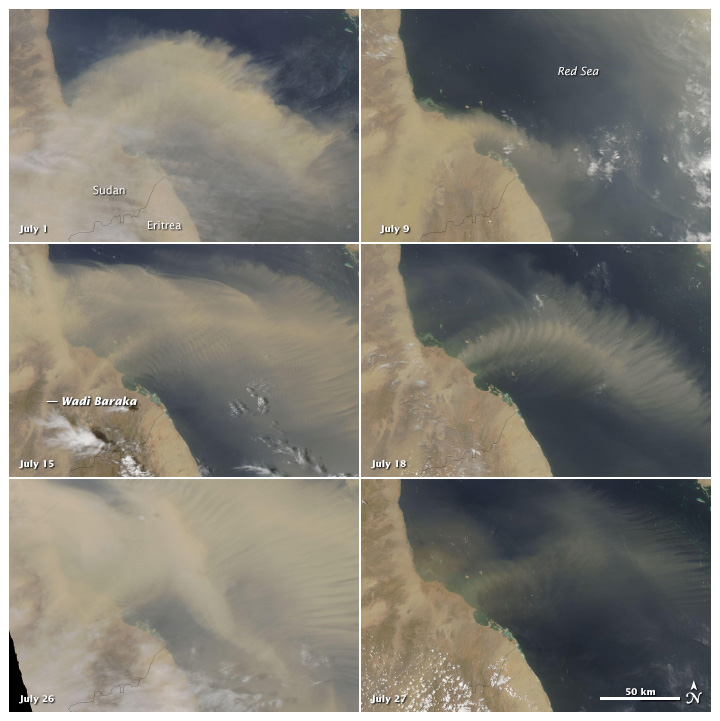
acquired July 1, 2013
download large image (535 KB, JPEG, 3328x2140)
acquired July 9, 2013
download large image (479 KB, JPEG, 3328x2140)
acquired July 15, 2013
download large image (672 KB, JPEG, 3328x2140)
acquired July 18, 2013
download large image (534 KB, JPEG, 3328x2140)
acquired July 26, 2013
download large image (404 KB, JPEG, 3328x2140)
acquired July 27, 2013
download large image (659 KB, JPEG, 3328x2140)
Nearly every day in July 2013, the Moderate Resolution Imaging Spectroradiometer (MODIS) on NASA’s Aqua and Terra satellites observed dust
blowing from Sudan over the Red Sea. On some days, the sea was cloaked
in a cloud of yellow. On other days, distinct plumes stretched out over
the water. On the clearest days, the dust cast a faint haze across the
atmosphere. In almost every instance, the storms showed a distinctive
pattern: Dust blew east over the water, then took a sharp turn to the
south. The pattern is interesting not because it’s unusual, but because
it’s so consistent.
Why is there so much dust in the air? Summer weather patterns—and
dust storms—in Sudan are dominated by moist air from tropical
rainforests to the southwest. As summer progresses, the moist air
gradually moves north and east, eventually reaching the extremely hot,
arid north. As the moist air warms, it rapidly rises and forms powerful
thunderstorms with strong winds that sweep dust across the country.
The other ingredient in Sudan’s dusty summer is water. In this
parched landscape, water flows intermittently, with lakes and streams
forming in the wet season and disappearing in the dry season. The
evaporating water leaves fine dust that is easily picked up by the wind,
so dust sources are mostly associated with former lakebeds or wadis.
The persistent dust plumes shown in the images above mostly originate
from the web of streams and wetlands associated with the Wadi Baraka.
The southward curve of the dust over the Red Sea is due to winds. The
dust blows east on the winds that control Sudan’s summer weather. But
once the plume is over the Red Sea, it encounters air moving southeast.
During the summer months, wind blows consistently southeast along the length of the Red Sea.
References
- Library of Congress (1991) Climate. In Sudan: A country study, Helen Chapin Metz, ed. Accessed July 29, 2013.
- Prospero, J. M. et al. (2002, February). Environmental characterization of global sources of atmospheric soil dust identified with the Nimbus 7 Total Ozone Mapping Spectrometer (TOMS) absorbing aerosol product. Reviews of Geophysics, 40:1. Accessed July 29, 2013.
NASA images courtesy Jeff Schmaltz, LANCE/EOSDIS MODIS Rapid Response Team at NASA GSFC. Caption by Holli Riebeek.
- Instrument:
- Aqua - MODIS
NASA: Red Sea area - Blowing from Sudan - A Persistent Plume over the Red Sea - 09.08.13
Ricardo M Marcenaro - Facebook
Blogs in operation of The Solitary Dog:
Solitary Dog Sculptor:
http://byricardomarcenaro.blogspot.com
Solitary Dog Sculptor I:
http://byricardomarcenaroi.blogspot.com
Para:
comunicarse conmigo,
enviar materiales para publicar,
propuestas comerciales:
marcenaroescultor@gmail.com
For:
contact me,
submit materials for publication,
commercial proposals:
marcenaroescultor@gmail.com
Diario La Nación
Argentina
Cuenta Comentarista en el Foro:
Capiscum
My blogs are an open house to all cultures, religions and countries. Be a follower if you like it, with this action you are building a new culture of tolerance, open mind and heart for peace, love and human respect.
Thanks :)
Mis blogs son una casa abierta a todas las culturas, religiones y países. Se un seguidor si quieres, con esta acción usted está construyendo una nueva cultura de la tolerancia, la mente y el corazón abiertos para la paz, el amor y el respeto humano.
Gracias :)

No hay comentarios:
Publicar un comentario